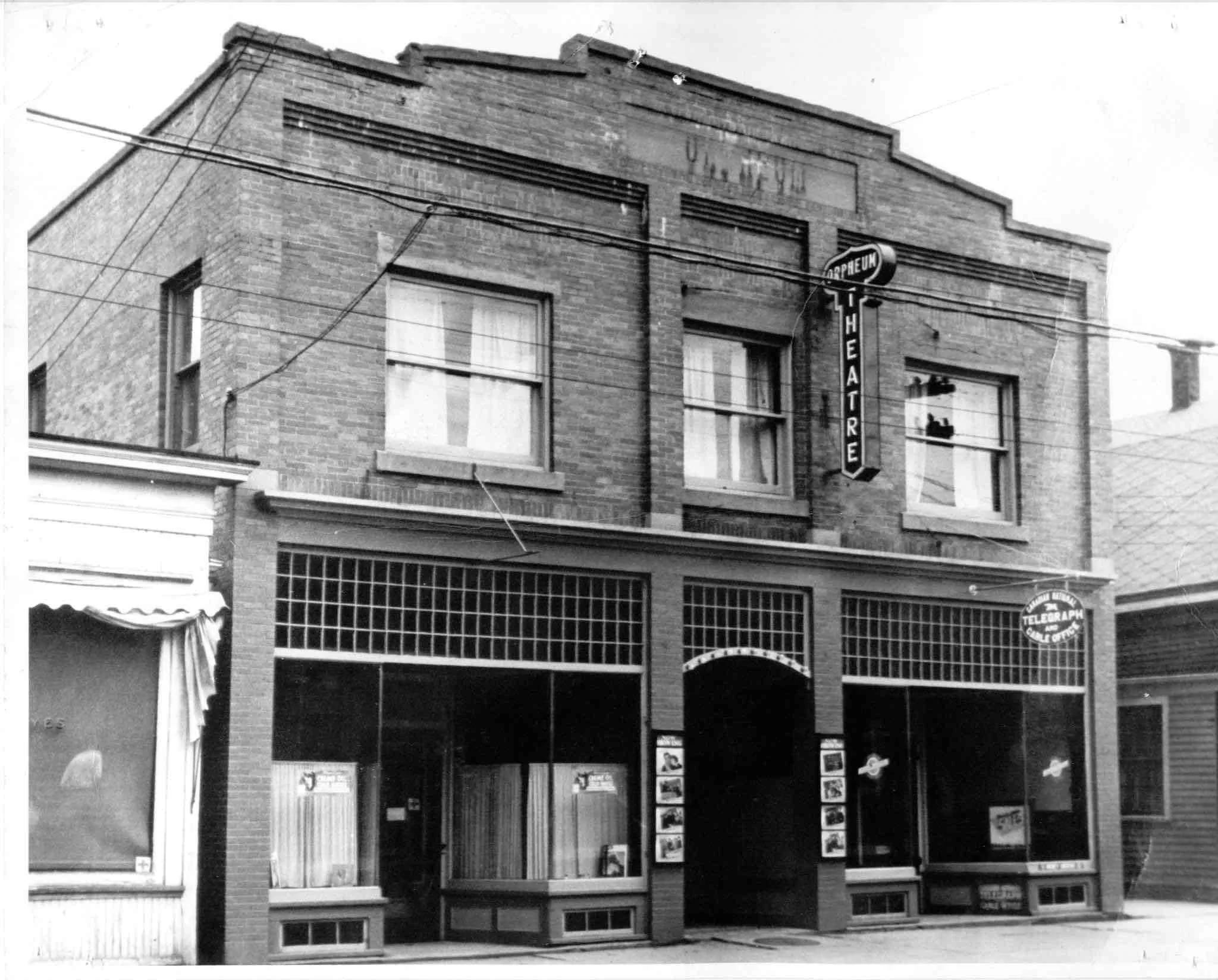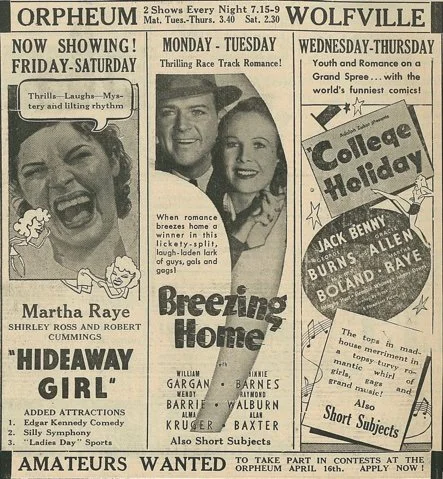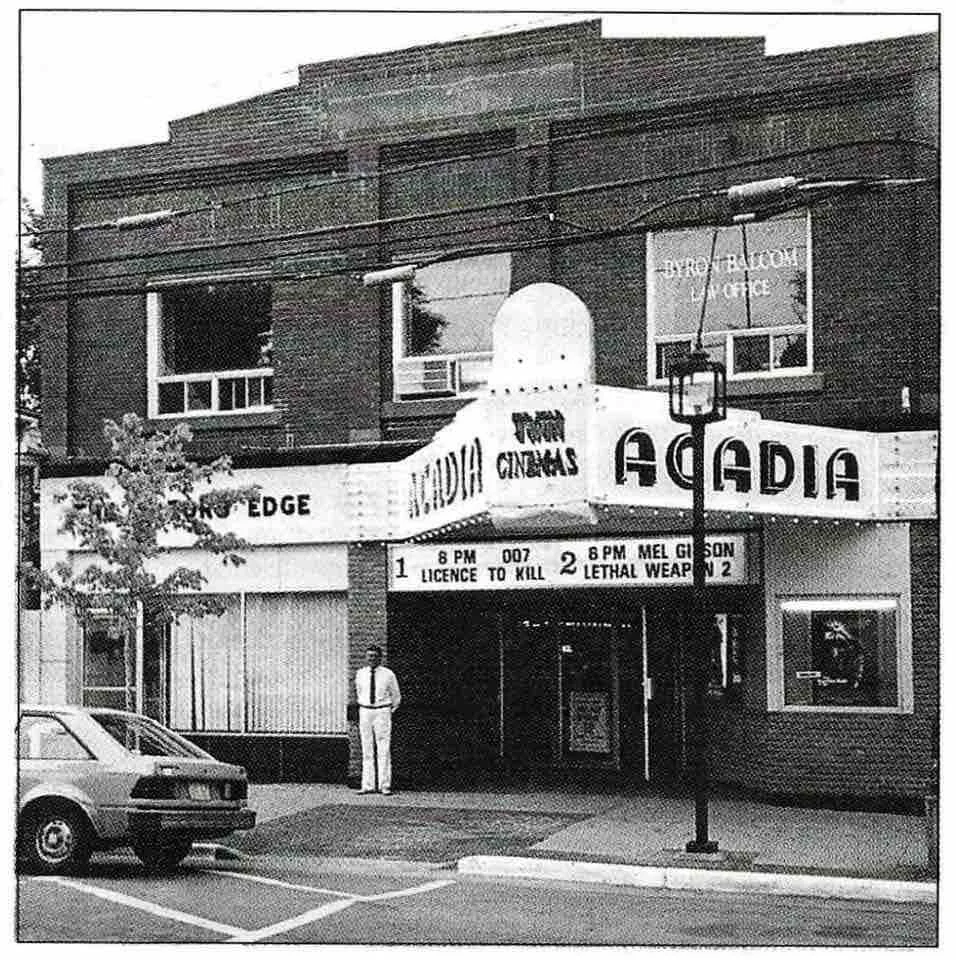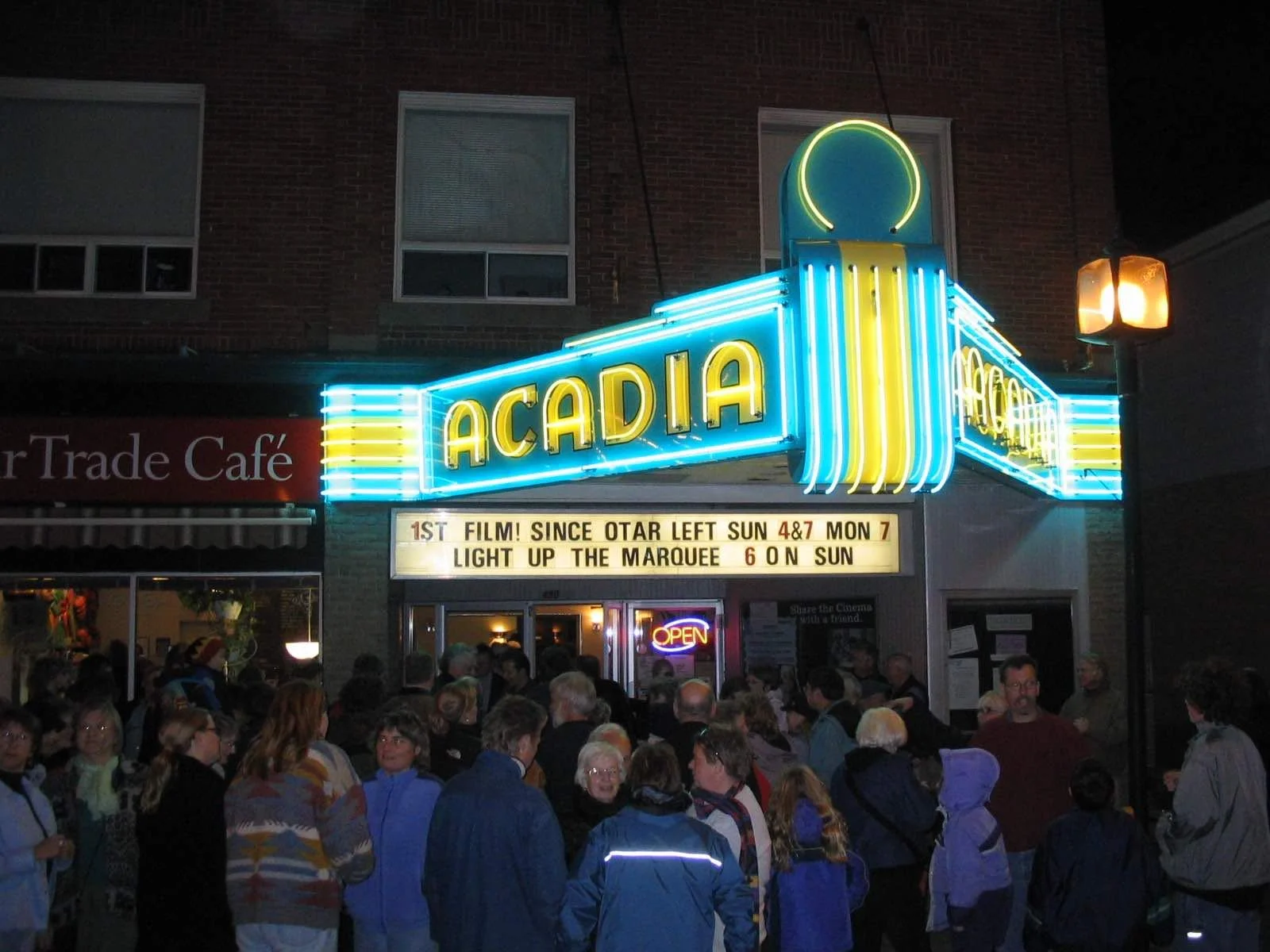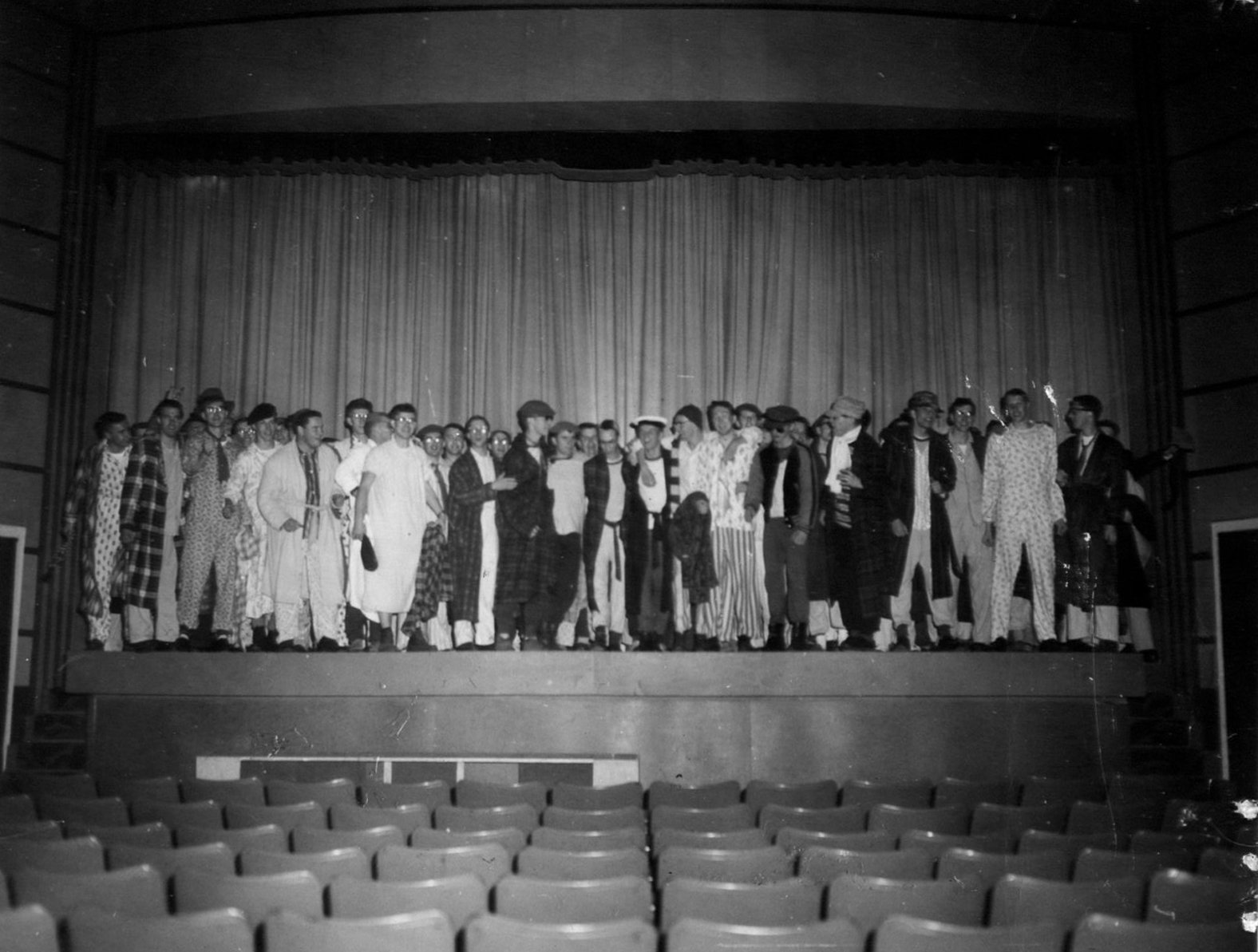
OUR HISTORY
The site’s original life as a theatre venue began in 1911 when Marshall and Ellouise Black established the Opera House on the back of the existing T.E. Hutchinson building. Renamed, refurbished and rebuilt over the years, it became the Orpheum Theatre (1923), the Acadia Theatre (1947), Acadia Cinema (1953) which morphed into the Acadia Twin Cinemas (1986), and finally the Acadia Cinemas (a tri-plex, 1997), which closed when Al Whittle, manager of 47 years, retired in 2000. The Acadia Cinema Cooperative Ltd. opened the doors of the Al Whittle Theatre with an anchor-tenant Fundy Film Society screening on November 7, 2004.
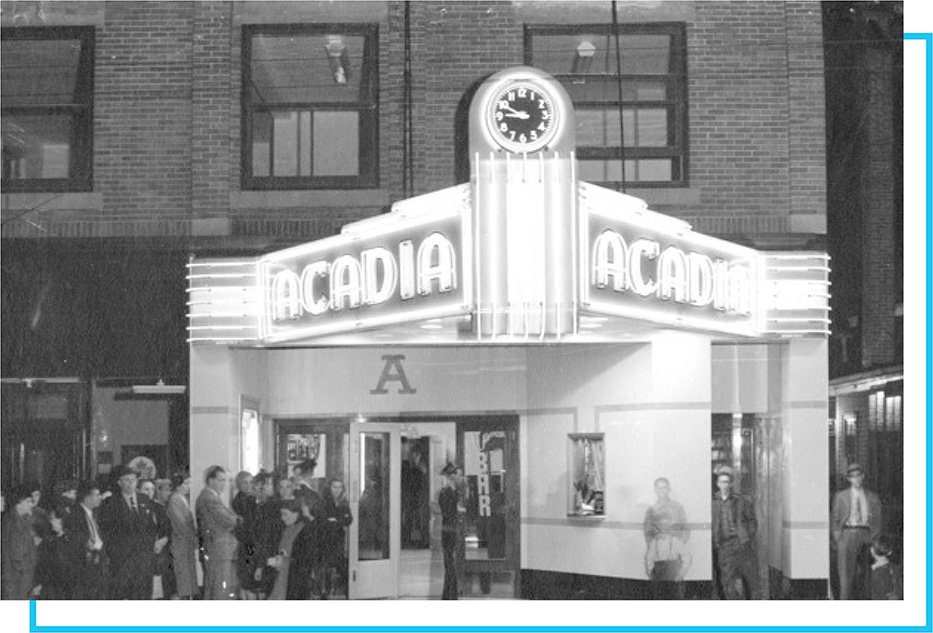
1911 - 1947: Opera and Orpheum
-
![]()
Opera House 1911 – 1923: A Cultural Renaissance
In the first decade of the 1900's a cultural wave swept Nova Scotia. Numerous grand opera houses, cultural centres and stage houses arose, from Yarmouth to Sydney.
In Wolfville, the Niklet was hosting weekly “motion pictures” in the Temperance Hall when William Marshall Black purchased the business. To expand, Black began construction on the back of Main Street's T.E. Hutchinson building which his wife Ellouise E. Black purchased on January 16, 1911. By July, Valley residents stepped into a completed 500 seat Opera House with “Up-to-date Equipment”, steam heat, electric lights and “a telephone from the Box office to the Stage.”
-
![]()
Opening Days
Even though the venue was “not nearly completed” the first event occurred June 13, 1911 when the management made “temporary” arrangements to give “everyone an opportunity to view…A Tale of Two Cities…over three thousand feet of moving picture…in a well ventilated roomy house.”
The next evening a selection of motion pictures was screened and a telephone and telegraph were brought in to present provincial election results “from the stage.” (Liberal George Henry Murray won, Nova Scotia's ninth and longest serving Premier-27 years).
The first professional live event in the completed facility was Hal Reid's At The Old Crossroad (August 1, 1911).
-
![]()
Opera House Offerings
From opera and operetta, vaudeville and traveling theatre companies, local school and Acadia University productions and “young ladies from Wolfville” providing musical and dramatic entertainment”, to silent motion pictures, Chautauqua, community meetings and “a direct wire from Halifax Headquarters” [that] “provided the latest flashes of war news” (August 1914)-the new “Modern Theatre” presented all this and more.
-
![]()
Orpheum Theatre 1923 – 1947: An Era Ends
Nathaniel (Nat) Evans bought the Opera House (1921). The final presentation before extensive renovations began was D.W. Griffiths’ Orphans of the Storm (July 18, 1923). The Acadian newspaper suggested that “business in Wolfville was down” during the months of the facility's closure.
The Orpheum Theatre celebrated its grand opening on November 19, 1923. “The front of the the stage was banked with cut flowers.” Wm. Roche, Jr. played piano for the seven reel silent motion picture, The Dangerous Age. Sammy Shields sang and P. C. Shortis performed on banjo and violin. Wednesday of the opening week, the Swiss Bell Ringers provided a performance. They sang and played “handbells, xylophones, saxophones, musical glasses and other interments. Every number was thoroughly enjoyed and loudly encored.”
-
![]()
Renovation Details
The new entrance was moved to the centre of the building with stores on either side. The brick front…“is a big addition to the business places on Main Street.” By 1924 an electric T-shaped “Orpheum Theatre” sign hung over the entrance.
When audience members stepped inside they saw a new arched ceiling “painted a delicate cream” and crimson walls decorated with “panels of gilt” Three “fixtures of great brilliancy and wall brackets in the form of candles” provided illumination
A new projector was installed and the old projector was “put in perfect condition.” A new Wurlitzer was also installed and furnished music for the feature on Tuesday of the first week–yet another performance with a “S.R.O. sign.”
-
![]()
Orpheum Entertainment
The variety of entertainment that first week reflected a sample of both what had come before and what lay ahead over the next 24 years, including those of the Second World War.
Events at the theatre included presentation and meeting of community and education groups—a small sample:
• Yearly high school Christmas season “extravaganza”
• High School Competition Concerts
• Acadia Seminary Glee Club Operetta
• “Liberal-Conservative Party gathering featuring G.C. Nowlan and Hon. W.. Hall” bracketed in the ad with screenings of Nothing But the Truth
• Local “amateur night” between film screenings on Saturdays
• Thanksgiving “union services at the local theatre”
• “Sing-Song” with a collection for war relief -
![]()
The Features and the “Talkies”
Features were straight from Hollywood and screened every day of the week except Sunday. Eventually matinees were scheduled for the students at 3:40 (Tuesdays and Thursdays) with regular matinees (Sat. & Holidays) at 2:30. Community events were mostly advertised on-site at the theatre.
It was during the Orpheum Theatre years that films with sound first came to Wolfville. Early films used a series of records with music and sound effects to accompany the reels. The installation of RCA Photophone Sound Equipment in June 1930 heralded the coming of the “talking picture”. The Most Immortal Lady (July 6-8, 1930) was the first “100% Singing and Talking” motion pictures to be shown at the theatre. “Prices: Adults 44 cents, Children 27 cents.”
1947 - Today: Acadia Theatre and Cinema
-
![]()
Acadia Theatre 1947 – 1952 - A Modern Theatre
The grand old Orpheum Theatre closed its doors forever on April 5, 1947 at the conclusion of the 8:45pm screening of Heldorado starring Roy Rogers and Trigger!
Gerald Spencer of St. John, N.B. had purchased the building “and the present [wooden] premises [would be] replaced by a new theatre which it is stated will be a credit to the Town of Wolfville and the owners alike”. And in fact it would be “more attractive and modern than any in the Maritime Provinces.”
With Bing Crosby's hit musical Welcome Stranger on the new “Acadia” neon marquee, the doors opened to the public on Monday October 6, 1947. Under the management of Mr. William Clamp, “this fine theatre capable of holding approximately 700 people was filled to overflowing for both performances.”
-
![]()
Less Stage and More Screen
The old stage was now gone. Initially, a temporary stage was available to continue support for community events, as had been the case for the past 35 years. The new Acadia Theatre, however, was first and foremost a motion picture venue, so eventually the stage was retired.
“Going to the movies” was by now a significant part of Acadia University life and this continued during the early years of the Acadia Theatre as well. But student interest increased even more with the arrival of a new young manager in 1953.
-
![]()
Acadia Cinema 1952 - 2000
From the start Al kept up with industry advances. He supervised the conversion of the theatre to CinemaScope. “The Robe in CinamaScope” was the first feature. It screened at the Acadia Theatre on October 20, 1854.
Al always had his patrons' interests in mind. In 1967 he reduced the seat numbers to provide more legroom between rows.
-
![]()
The Twinning
With “the best of the best” Al opened the new “Acadia Twin Cinemas” on June 20, 1986 with Tom Cruise in Top Gun and Sylvester Stallone in Cobra. He installed a brand new sound system and the original theatre was divided down the middle, losing 75 seats and leaving two theatres-one holding 230 and the other 175. Al wanted to offer his patrons “twice the choice in movie viewing”, he told The Kentville Advertiser, “at a time when viewers expect it.” Corporate multiplexes (late 70’s), and the VHS (home video) market which burgeoned in the mid-80’s put great pressure on independent cinemas across Canada, including Woflville’s Acadia Cineam. Twinning was a response to these phenomena. But the name “Twin Cinemas” never really stuck.
-
![]()
University and the Acadia Cinema
Strong ties developed early between Acadia students, Al and his movie theatre. not only did he employ students (as ushers, ticket and concession sellers and for help with renovations) but Al also created special events with students in mind. Legendary is The Pajama Game screening (1958). A university newspaper ad read “free movie for those in pajamas.” Perhaps generating anxiety in those responsible for female students (who snuck out to attend), the event nevertheless resulted in a large turnout of PJ-clad students of both genders!
Later, with the demise of 16mm, the university also looked to the Acadia. The Atheneum’s “World Cinema Comes to the Valley” (January 1988) announced the launch of “a new Acadia Film Society” citing screenings at Main Street’s “Acadia Cinema [being] advantageous for the big screen, sharp image, professional sound and comfortable seating.” There were still screening in 1994.
-
![]()
Out with a Flourish
Al Whittle continued to manage and improve the theatre to keep it viable. An expanded lobby with a new concession counter and ticket desk came next (1989). A third screen was added (1997) and then Al instituted the very popular Sunday “Tea Time Matinees”.
In 2000, when A. Ellsworth Whittle retired as manager of the Acadia Cinema after 47 years, the theatre closed and was put on the market for sale.
-
![]()
When a Door Closes, Another One Opens
The Acadia Cinema’s end (2000) left a hole in the heart of Main Street, a long-cherished tradition gone forever and a significant cultural gap to be filled. A new Fundy Film Society (FFS) rose to the occasion. With no home in town, screenings began at the Empire Theatres (2002). Success was immediate.
October 2002: Fundy Film Society Board member, Al Whittle, still supervising the building, permitted Fundy Film volunteers to sell tickets for their Empire screenings in the former Acadia lobby. While there selling tickets, Al shared the news: the latest deal for the building, a hotel, had fallen through and “it’s back on the market” he told a little band of FFS members. On that day those present hatched a serious plot to purchase, rebuild and re-open a new theatre in the Acadia Cinema building.
-
![]()
A New Cooperative
Before the end of 2002, a Steering Committee, eight volunteers, had worked out a plan and three signed papers to create the Acadia Cinema Cooperative, Ltd (December 2002). Shares ($100) went on sale in January 2003.
Across Canada and the world Acadia alums and former residents joined the wider local community and fellow Nova Scotians to save the theatre. An early share purchase came from Japan!
By March 2003, the new Cooperative, with a Board of Directors, had raised over $120,000 in share sales and was able to enter into a joint agreement with Just Us! Coffee Roasters Co-op to purchase the Acadia Cinema building from the owners, Al’s original employer in New Brunswick. ACC would develop, own and operate the new theatre facilities. Just Us! would do likewise for a cafe on site.
-
![]()
Volunteer Success Story
From the earliest days ACC has received unprecedented support from shareholder and community volunteers who planned and even designed the 160 seat, state-of-the-art venue for cinema and live performance.
Two volunteers removed the tri-plex’s walls while another Co-op crew refurbished the second-floor rental income apartment. (Summer 2003). Inquires, then contract bids, were made.
Creative volunteer PR efforts led to more share sales which helped complete the purchase and the Co-op applied for and received a federal (ACOA) grant allowing construction to begin (May 2004). More volunteer work completed the space enough to welcome anchor tenant Fundy Film Society to open the theatre (Fall 2004).
-
![]()
Grand Opening for Al’s Place
Wolfville’s Main Street was packed at dusk on November 7, 2004, awaiting the formal “lighting” of the “Acadia” landmark marquee. Newly refurbished with contributions from both the Town of Wolfville and Acadia University. Mayor Stead and President Dinter-Gottlieb pulled the symbolic lever (volunteer built) to the crowd’s delight. The FFS patrons entered the new Al Whittle Theatre, named in honour of the man who had lovingly managed the former movie house for 47 years.
With funding assistance from community businessman John MacKay, the superior sprung stage was installed and more volunteers completed the theatre enough to book live events (early 2005).
-
![]()
Community Cultural Facilities
Today’s facilities have evolved to include Jack’s Gallery in the lobby (2009) and second floor Studio-Z (2010). The Acadia Cinema’s Al Whittle Theatre hosts the broadest range of live performance and weekly cinema while offering a superb venue for community, cultural and educational opportunities.





